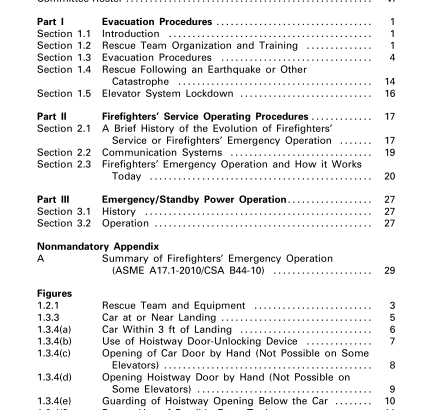ASME A17.4-2015 pdf free download.Guide for Emergency Personnel (Includes Evacuation Procedures and Firefighters’ Service Operating Procedures)
1.2.4 Door Restrictors (Restricted Door Operation) Many elevator car and/or landing doors are equipped with door restrictors to prevent opening of the car doors or landing doors from inside the car when the car is outside the unlocking zone. These devices are required by ASME A17.1/CSA B44 and ASME A17.3 to be installed in such a manner that the doors can be opened from outside the car without special tools. Emergency personnel should become familiar with how these devices can be opened from the landing before an actual emergency occurs. SECTION
1.3 EVACUATION PROCEDURES
1.3.1 Communication Prior to conducting an evacuation, the following steps should be taken:
(a) The responsible personnel in the building should immediately be stationed outside of the stalled elevator and communicate with the occupants of the elevator car to inform them that
(1) they are safe
(2) steps are being taken to evacuate them from the elevator car
(3) they should stand clear of doors since they may be opened
(4) they should refrain from smoking
(5) they should not attempt to exit the car
(b) In communicating with the occupants of the elevator car, the following information should be obtained for guidance in making decisions on actions to be taken in the rescue operation:
(1) the number of persons in the elevator car
(2) whether any of the occupants of the elevator car have an immediate medical concern
(3) whether the lights are on in the elevator car
(4) the location of the elevator car in the hoistway, if known
(c) One member of the rescue team should be stationed at the location of the elevator mainline disconnect to open or close the mainline disconnect switch as required by the evacuation team. Two-way communication should be maintained between these team members. The rescue team should verify that these steps have been taken, and while the rescue operation is in progress, the occupants of the elevator car should continually be kept informed and reassured of their safety.
1.3.2 Assessment of Conditions It is recognized that the preferred safe practice in evacuating passengers is to move the elevator car to a landing level. The procedures outlined herein do not require the movement of the elevator car by any means other than normal inspection or Phase I operation. The elevator car will not move if the safety circuit is open.
Movement of the elevator car by any other means should be attempted only under the direct supervision of experienced elevator personnel. Before utilizing any of these procedures, ascertain that the mainline disconnect switch is in the “ON” position (closed) and that the emergency stop switch, if the car is so equipped, is in the “RUN” position, not in the “STOP” position.
If the elevator is equipped with firefighters’ service operation, try activating the Phase I lobby key switch to recall the elevator car to the main floor.
If the elevator car is stalled due to a loss of power to the building, and the building has a standby or emergency power source equipped to operate the elevators, it may be possible to run the elevators by turning the emergency recall switch in the main floor lobby to the “ON” position.
Use the manual elevator standby power selection switch, if provided, to bring the elevator cars to the main floor, one by one.
If these methods do not work, determine the position of the elevator car as specified in 1.3.3 through 1.3.5 and continue with the evacuation procedure that is appropriate.
1.3.3 Procedure With Car at or Near a Landing When an elevator car is located at or near a landing (see Fig. 1.3.3), it may be that the hoistway door is unlocked, and the hoistway and car doors can be opened by hand. Under these conditions, proceed as follows: (a) Set the mainline disconnect switch for the stalled elevator in the “OFF” position. Lockout/tagout the mainline disconnect switch. (b) Open the doors by hand.ASME A17.4 pdf download.ASME A17.4-2015 pdf free download
